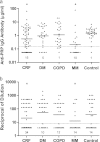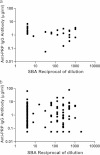Risk of invasive Haemophilus influenzae type b (Hib) disease in adults with secondary immunodeficiency in the post-Hib vaccine era
- PMID: 22398246
- PMCID: PMC3346318
- DOI: 10.1128/CVI.05675-11
Risk of invasive Haemophilus influenzae type b (Hib) disease in adults with secondary immunodeficiency in the post-Hib vaccine era
Abstract
Prior to the introduction of Haemophilus influenzae type b (Hib) conjugate vaccines, invasive Hib disease affected almost exclusively children. According to some recent studies, in the postvaccine era, adults, the elderly, and immunocompromised persons can be affected more often than children. As the production of type-specific anti-capsular polysaccharide antibodies is the major defense mechanism against Hib, individuals with defects in humoral immune responses have high susceptibility to infections caused by Hib. We hypothesized that nonvaccinated adults with chronic conditions causing immunosuppression may lack protective antibody to Hib. We assessed serum anti-Hib IgG levels and bactericidal activity in 59 patients with chronic renal failure, 30 patients with type 2 diabetes mellitus, 28 patients with chronic obstructive pulmonary disease (COPD), and 20 patients with multiple myeloma compared to 32 healthy controls of similar age. Considering antibody at >0.15 μg/ml as the protective correlate in unvaccinated individuals, we detected subprotective Hib antibody levels in 29% of chronic renal failure, 20% of diabetes, 14% of COPD, and 55% of myeloma patients compared to 3% of healthy controls. Additionally, 70% of myeloma and 58% of chronic renal failure patients did not have detectable serum bactericidal activity against Hib. Among individuals with severe diseases causing secondary immunodeficiency, patients with multiple myeloma and chronic renal failure are at an increased risk of invasive Hib disease. Considering that Hib continues to circulate in the population, this study provides a rationale for the immunization of some adult patients with secondary immunodeficiency with the pediatric Hib vaccine to achieve protective immunity.
Figures



Similar articles
-
Protective immunogenicity of Haemophilus influenzae type b polysaccharide-tetanus protein conjugate vaccine in children who failed to respond to prior invasive H. influenzae type b disease.Pediatr Allergy Immunol. 1998 Aug;9(3):156-60. doi: 10.1111/j.1399-3038.1998.tb00363.x. Pediatr Allergy Immunol. 1998. PMID: 9814731
-
Antibodies prevalence against Haemophilus influenzae type b in Jeddah population, Saudi Arabia. I. Total antibodies.Hum Antibodies. 2018;26(4):225-235. doi: 10.3233/HAB-180342. Hum Antibodies. 2018. PMID: 29945350
-
Haemophilus influenzae serotype b conjugate vaccine failure in twelve countries with established national childhood immunization programmes.Clin Microbiol Infect. 2010 Jul;16(7):948-54. doi: 10.1111/j.1469-0691.2009.02945.x. Epub 2009 Nov 4. Clin Microbiol Infect. 2010. PMID: 19889054
-
Circulating innate and adaptive immunity against anti-Haemophilus influenzae type b.Hum Antibodies. 2019;27(3):201-212. doi: 10.3233/HAB-190373. Hum Antibodies. 2019. PMID: 30958343 Review.
-
Two decades of experience with the Haemophilus influenzae serotype b conjugate vaccine in the United Kingdom.Clin Ther. 2012 Feb;34(2):385-99. doi: 10.1016/j.clinthera.2011.11.027. Epub 2012 Jan 12. Clin Ther. 2012. PMID: 22244051 Review.
Cited by
-
Immune defects in the risk of infection and response to vaccination in monoclonal gammopathy of undetermined significance and multiple myeloma.Front Immunol. 2014 Jun 3;5:257. doi: 10.3389/fimmu.2014.00257. eCollection 2014. Front Immunol. 2014. PMID: 24917865 Free PMC article. Review.
-
The effect of rituximab on vaccine responses in patients with immune thrombocytopenia.Blood. 2013 Sep 12;122(11):1946-53. doi: 10.1182/blood-2013-04-494096. Epub 2013 Jul 12. Blood. 2013. PMID: 23851398 Free PMC article. Clinical Trial.
-
Type 5 secretion system antigens as vaccines against Gram-negative bacterial infections.NPJ Vaccines. 2024 Sep 1;9(1):159. doi: 10.1038/s41541-024-00953-6. NPJ Vaccines. 2024. PMID: 39218947 Free PMC article. Review.
-
Epidemiology of Invasive Haemophilus influenzae Disease, Europe, 2007-2014.Emerg Infect Dis. 2017 Mar;23(3):396-404. doi: 10.3201/eid2303.161552. Emerg Infect Dis. 2017. PMID: 28220749 Free PMC article.
-
Effectiveness of Haemophilus influenzae type b vaccination after splenectomy - impact on selected immunological parameters.Hum Vaccin Immunother. 2019;15(2):339-348. doi: 10.1080/21645515.2018.1537744. Epub 2018 Nov 5. Hum Vaccin Immunother. 2019. PMID: 30352001 Free PMC article.
References
-
- Adam HJ, et al. 2010. Changing epidemiology of invasive Haemophilus influenzae in Ontario, Canada: evidence for herd effects and strain replacement due to Hib vaccination. Vaccine 28:4073–4078 - PubMed
-
- Amir J, Liang X, Granoff DM. 1990. Variability in the functional activity of vaccine-induced antibody to Haemophilus influenzae type b. Pediatr. Res. 27:358–364 - PubMed
-
- Anderson P. 1984. The protective level of serum antibodies to the capsular polysaccharide of Haemophilus influenzae type b. J. Infect. Dis. 149:1034–1035 - PubMed
-
- Bender JM, et al. 2010. Invasive Haemophilus influenzae disease in Utah children: an 11-year population-based study in the era of conjugate vaccine. Clin. Infect. Dis. 50:e41–e46 - PubMed
-
- Castle SC. 2000. Clinical relevance of age-related immune dysfunction. Clin. Infect. Dis. 31:578–585 - PubMed
Publication types
MeSH terms
Substances
LinkOut - more resources
Full Text Sources
Medical
Research Materials

